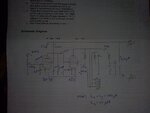andreidaniel
Member level 2

- Joined
- Sep 18, 2010
- Messages
- 42
- Helped
- 1
- Reputation
- 5
- Reaction score
- 2
- Trophy points
- 1,288
- Location
- Romania, Iasi City
- Activity points
- 1,818
Hi! I bought a two valve AM transmitter (MW or SW, depends on coils used).

The coils are switchable and in the diagram is shown the version when them are connected.
I made the kit for MW and it worked. After a while, when I was already tired unfortunately,by mistake I tried to bring closer the two inductances of 180uH with a patent.. At that time the kit was powered by 1,5V cell D + 44V (it works from 27 to 90V depends on what power do you need, and the recommanded voltage is 36V) from 5 cells 9V .. I made practically a short circuit between A and F points where are the two coils... Please have a look on the diagram again and tell me if it could be possible to be damaged the RF tube.. I measured the inductances because it got out fume and now one has 27uH and the other 16uH (from 170uH)..
Please I am desperate.. I tried even to make a SW coils with 12 wires but I cannot receive anything from 1,7 to 18MHz... Also I saw that on the top of RF tube is something like a rainbow..purple...is it normally? I did not remember if that was when I opened the box.
**broken link removed**

The coils are switchable and in the diagram is shown the version when them are connected.
I made the kit for MW and it worked. After a while, when I was already tired unfortunately,by mistake I tried to bring closer the two inductances of 180uH with a patent.. At that time the kit was powered by 1,5V cell D + 44V (it works from 27 to 90V depends on what power do you need, and the recommanded voltage is 36V) from 5 cells 9V .. I made practically a short circuit between A and F points where are the two coils... Please have a look on the diagram again and tell me if it could be possible to be damaged the RF tube.. I measured the inductances because it got out fume and now one has 27uH and the other 16uH (from 170uH)..
Please I am desperate.. I tried even to make a SW coils with 12 wires but I cannot receive anything from 1,7 to 18MHz... Also I saw that on the top of RF tube is something like a rainbow..purple...is it normally? I did not remember if that was when I opened the box.
**broken link removed**

